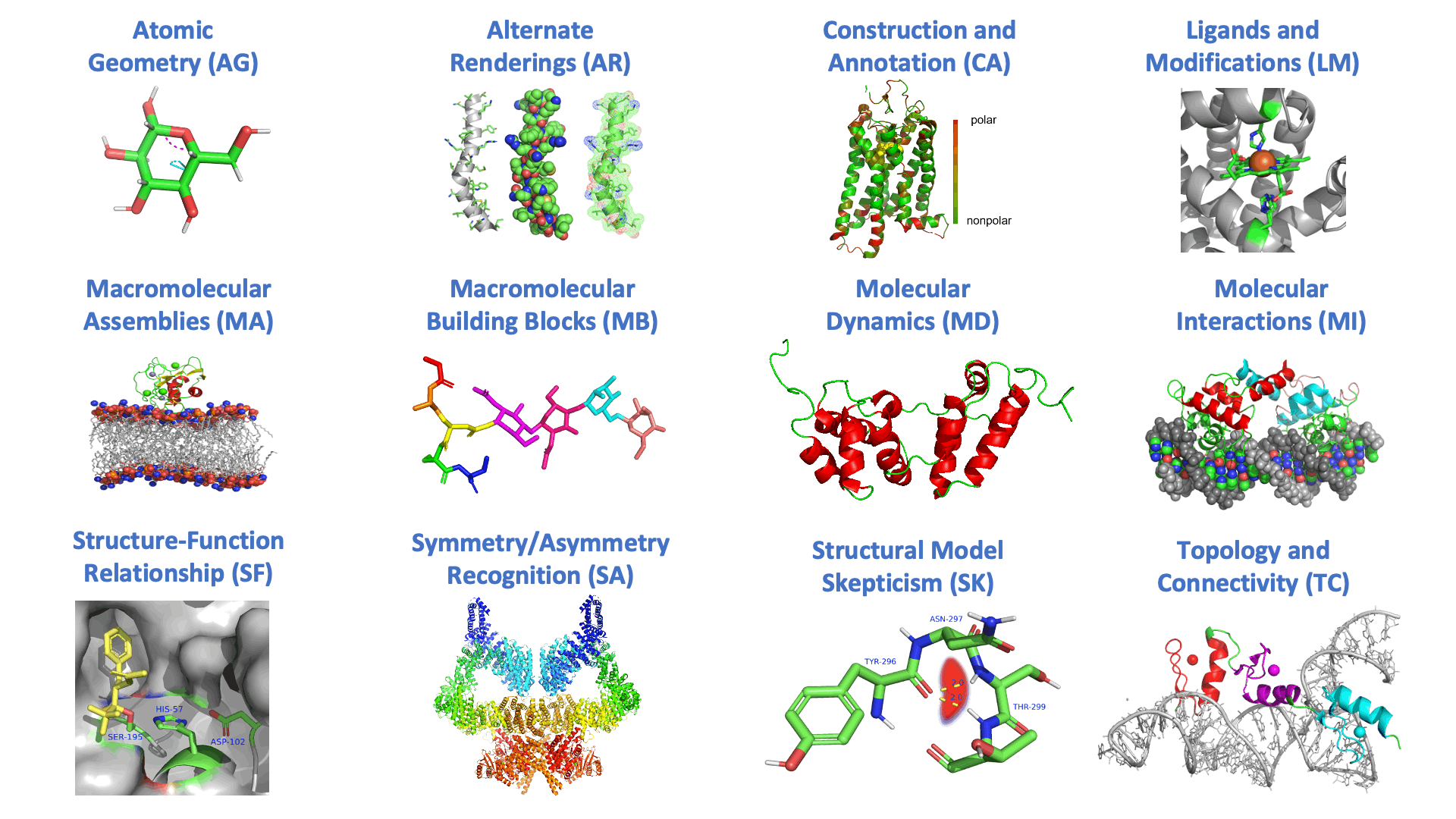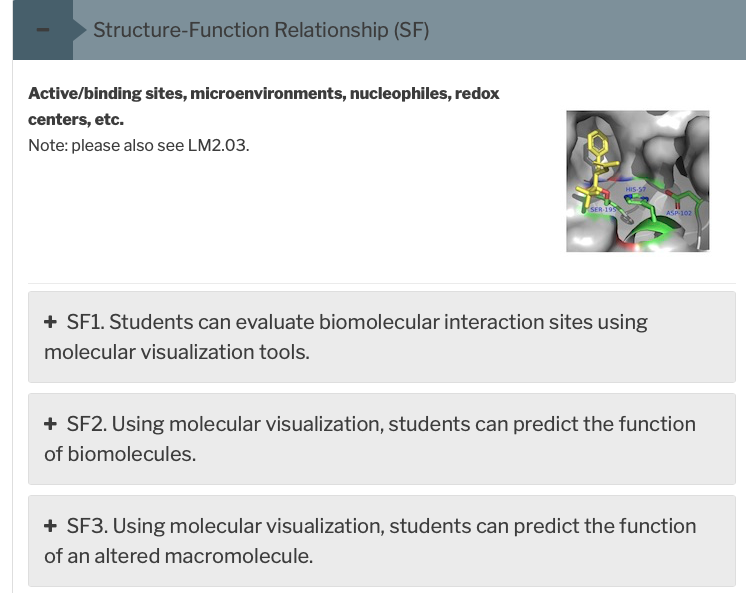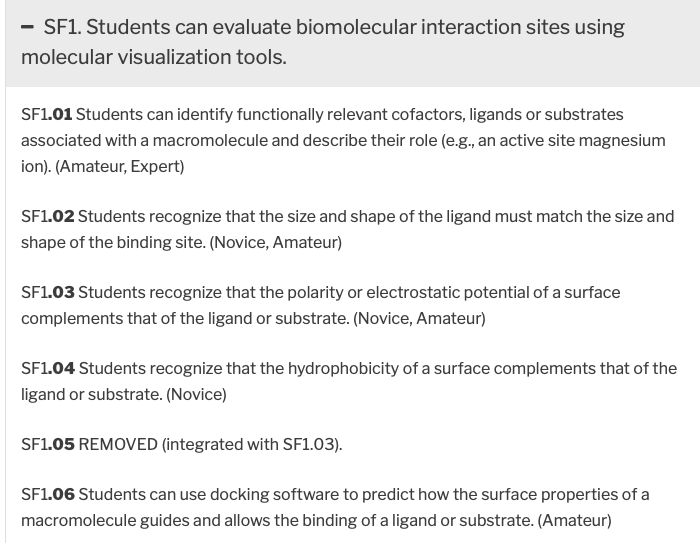3. The Biomolecular Visualization Framework
Pamela Mertz
Life science classes use lots of images of structures of biomolecules in textbooks and other resources, but what do students understand when they view these images? Studies suggest it may be different from what the instructor or another expert would see (Loertscher et al., 2014, Schönborn and Anderson, 2006, Beckham, et al. 2024). Thus, there is a need to intentionally scaffold molecular visualization skills at multiple levels to enhance students’ understanding of how a structure dictates function. In fact, visualization literacy skills are considered to be a threshold concept, a concept that needs to be mastered before a student can progress in learning (Loertscher et al., 2014). Students need to be able to understand overall biomolecular structures as well as analyze localized details such as intermolecular interactions in an enzyme active site. Despite the importance of building student visualization skills, these skills have been challenging to teach and assess.
To aid in assessing visualization skills, Bateman and Craig proposed a proficiency rubric (Bateman and Craig, 2010), which was refined with input from the biochemistry and molecular biology education community. This work developed into the BioMolecular Visualization Framework (Dries et al. 2017), but the Framework underwent several revisions, informed by faculty focus groups. The 2022 Framework is the current version.
Framework Organization
Overarching Themes
The BioMolecular Visualization Framework first defines 12 broad topics in biomolecular visualization. The dozen overarching themes encompass various aspects that are key to a thorough understanding of a molecular structure. The themes are represented pictorially below.

Learning Goals and Learning Objectives
Within each overarching theme, there are learning goals. As an example, Structure-Function Relationships is a theme with three learning goals:

Under each goal are learning objectives, which provide discrete tasks students should be able to perform. For example, under the first learning goal, SF1. “Students can evaluation biomolecular interaction sites using molecular visualization tools,” there are five learning objectives. (A sixth one, SF1.05 was integrated with SF1.03.)

Assessing Visual Literacy Skills
BioMolViz members use the Framework in a backwards design process (Wiggins & McTighe, 2005) to write molecular visualization assessments and as a guide for where attention should be put for themes that currently lack assessments. Assessments are housed in the BioMolViz Library (Beckham, 2023). As an example, the assessment below is Assessment ID 10013. The image for the assessment was created with PDB ID 1GPK.

The primary learning objective for this assessment is Ml1.03. The theme is Molecular Interactions (Ml), and the 1 after MI refers to the learning goal:
MI1. Students can predict the existence of an interaction using structural and environmental information (e.g. bond lengths, charges, pH, dielectric constant).
The 03 after the period refers to the learning objective:
MI1.03 Students can predict whether a functional group (region) would be a hydrogen bond donor or acceptor. (Amateur)
Searching the BioMolViz Library Using the Framework
Additional assessments can be obtained by requesting an account using this form. In the BioMolViz Library, assessments can be searched by a Theme, Goal, or Objective from the Biomolecular Visualization Framework.

References
Bateman, R.C.; Craig, P.A., A Proficiency Rubric for Biomacromolecular 3D Literacy, PDB Newsl. Educ. Corner (2010), 45, 5–7. https://cdn.rcsb.org/rcsb-pdb/general_information/news_publications/newsletters/2010q1/education_corner.html
Beckham, J., Acevedo, R., Dries, D.R., Engelman, S., Franzen, M.A., Jakubowski, H., Mertz, P., Novak, W.R., Roberts, R., Roca, A.I., Procko, K.* The BioMolViz Library: An Assessment Repository to Evaluate Biomolecular Visual Literacy Through the BioMolViz Framework. 2023. library.biomolviz.org (https://doi.org/10.15781/6mcy-8m69)
Beckham, J. T., Dries, D. R., Hall, B. L., Mitton-Fry, R. M., Engelman, S., Burch, C., Acevedo, R., Mertz, P. S., Vardar-Ulu, D., Agrawal, S., Fox, K. M., Austin, S., Franzen, M. A., Jakubowski, H. V., Novak, W. R. P., Roberts, R., Roca, A. I., & Procko, K. (2024). Seeing Eye to Eye? Comparing Faculty and Student Perceptions of Biomolecular Visualization Assessments. Education Sciences, 14(1), 94. https://doi.org/10.3390/educsci14010094
Dries, D. R., Dean, D. M., Listenberger, L. L., Novak, W. R., Franzen, M. A., & Craig, P. A. (2017). An expanded framework for biomolecular visualization in the classroom: Learning goals and competencies. Biochemistry and molecular biology education : a bimonthly publication of the International Union of Biochemistry and Molecular Biology, 45(1), 69–75. https://doi.org/10.1002/bmb.20991
Loertscher, J., Green, D., Lewis, J. E., Lin, S., & Minderhout, V. (2014). Identification of threshold concepts for biochemistry. CBE life sciences education, 13(3), 516–528. https://doi.org/10.1187/cbe.14-04-0066
Loertscher, J., Villafañe, S. M., Lewis, J. E., & Minderhout, V. (2014). Probing and improving student’s understanding of protein α-helix structure using targeted assessment and classroom interventions in collaboration with a faculty community of practice. Biochemistry and molecular biology education : a bimonthly publication of the International Union of Biochemistry and Molecular Biology, 42(3), 213–223. https://doi.org/10.1002/bmb.20787
Schönborn, K. J., & Anderson, T. R. (2006). The importance of visual literacy in the education of biochemists*. Biochemistry and molecular biology education : a bimonthly publication of the International Union of Biochemistry and Molecular Biology, 34(2), 94–102. https://doi.org/10.1002/bmb.2006.49403402094
Wiggins, G. P., & McTighe, J. (2005). Understanding by design. Ascd.
